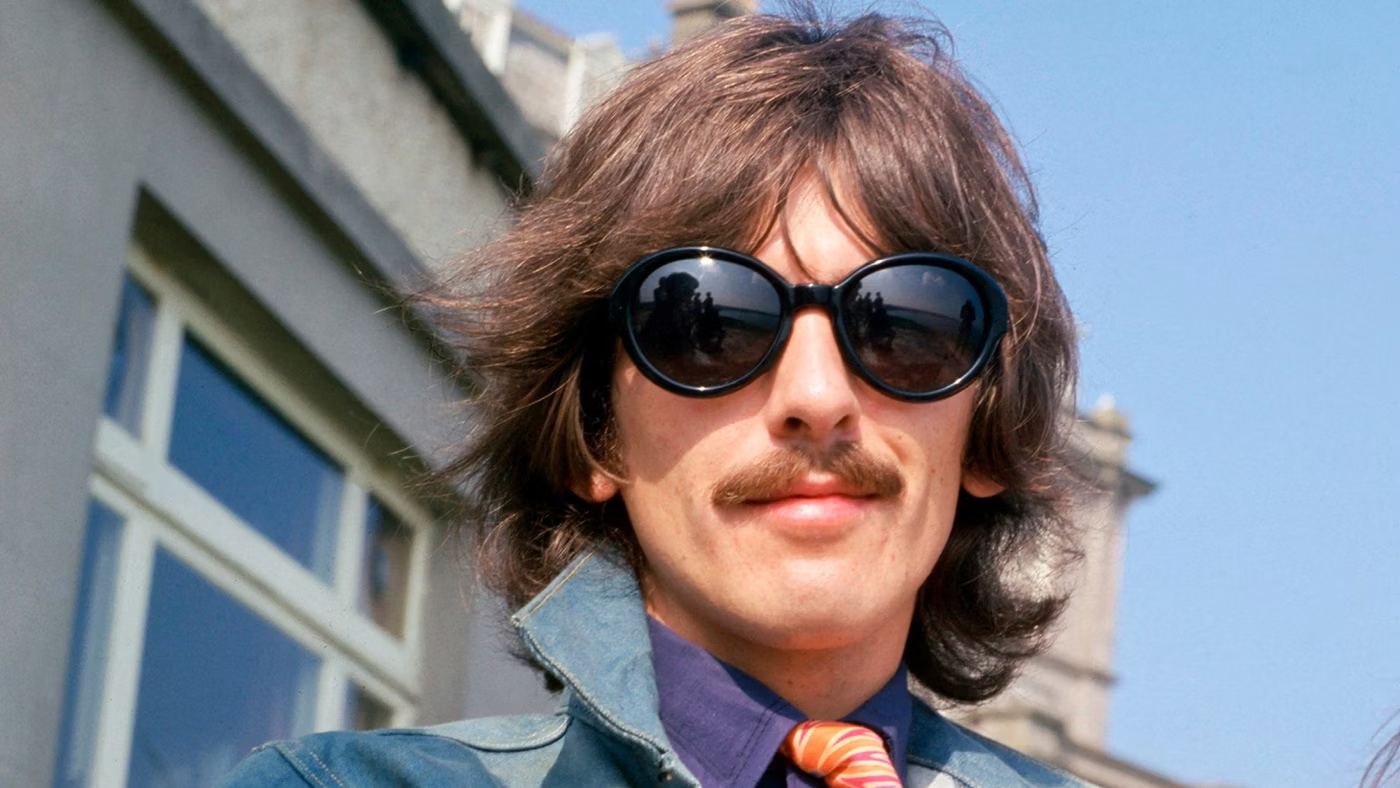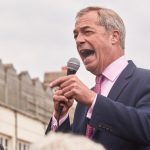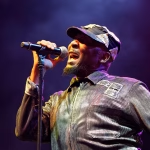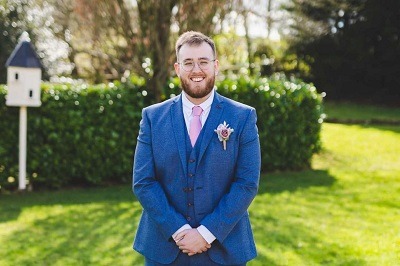Beyond the Guitar Hero – The Astounding Wealth of George Harrison
When you think of The Beatles, you often picture the vibrant energy, the iconic songs. But then there's George Harrison, the "Quiet Beatle," a man who seemed to carry a world of thought and introspection behind his often-serene gaze.
Yet, this wasn't just a spiritual journey; it was also an incredibly astute one that built a formidable financial legacy. When George left us in 2001, his fortune was estimated at a cool $400 million.
Fast forward to 2025, and with a bit of inflation adjustment and clever management, that sum would comfortably sit closer to $700-$800 million, possibly even brushing a billion. George wasn't just a masterful guitarist who carved out The Beatles' distinctive sound; he was a groundbreaking solo artist, a surprising film mogul, a devoted gardener, and a seeker of truth. His story is far richer than just the charts he topped.
John Lennon’s Net Worth 2025 – Beatles Legend’s Fortune Revealed
This updated look for 2025 isn't just about the numbers, though we'll certainly dive into those. It's about exploring the vibrant tapestry of George Harrison’s life and career, understanding how his estate has continued to flourish, and answering some burning questions about the money behind the music icon.
The Pillars of George Harrison's Wealth: Music, Film & Real Estate
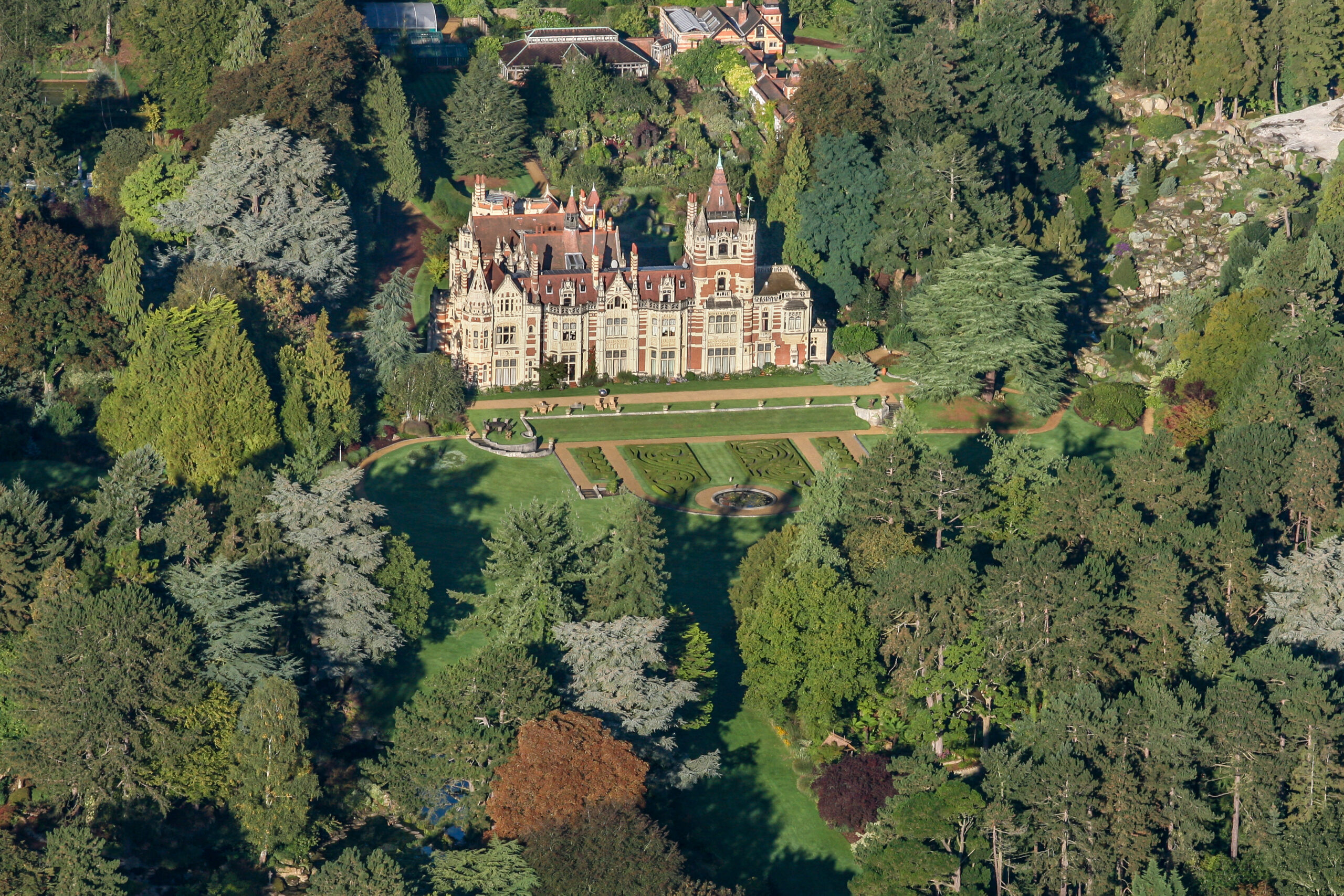
Friar Park, the stunning 120-room estate in Henley-on-Thames owned by George Harrison, captured in full from above with its intricate gardens and lush woodland surroundings.
George Harrison's wealth wasn't just handed to him; it was painstakingly built, piece by remarkable piece, reflecting not only his immense musical talent but also a sharp mind for business. His fortune at the time of his passing, and the way his estate has thrived since, comes from a truly diverse financial portfolio:
- The Unstoppable Juggernaut of Beatles Music Royalties: This was, without a doubt, the bedrock. As one of the four key figures in The Beatles' universe through Apple Corps, George commanded substantial songwriting and performance royalties. Think about it: his compositions like "Something" and "Here Comes the Sun" aren't just beloved classics; they're global streaming powerhouses, consistently racking up plays. The Beatles' entire catalog? It's one of history's most lucrative, pulling in hundreds of millions of dollars annually across every platform imaginable. While we don't get a peek at Apple Corps' exact books, insider estimates reveal just how significant this was. For instance, in one 12-month stretch around 2013, the four principals (or their estates) collectively pulled in an astonishing $71 million. George's share, while perhaps not reaching the dizzying heights of the Lennon-McCartney songwriting team, still consistently landed him around $6 million in that period, purely from The Beatles' continued popularity. Early on, the sheer volume of their record sales globally meant each Beatle was already a multi-millionaire, even before the band split.
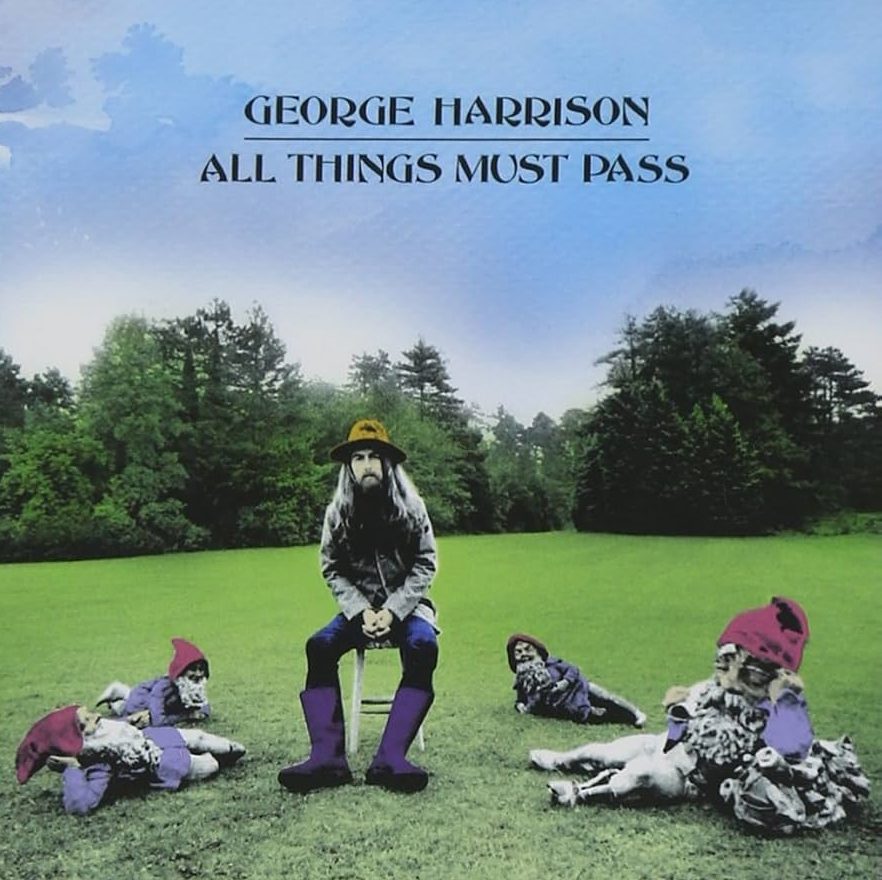
he surreal and symbolic cover of All Things Must Pass (1970) captures George Harrison seated solemnly amid gnomes on the grounds of his Friar Park estate—an image that reflected both whimsy and deep spiritual introspection during his first major solo release after The Beatles.
- His Solo Stride: A Goldmine of His Own Making: After The Beatles, George didn't just walk away; he soared. His triple-LP debut, All Things Must Pass, was more than just an album; it was a defiant statement, selling over 7 million copies worldwide and going 6x Platinum in the US by 2001. And those singles? "My Sweet Lord" was a global phenomenon, shifting over 5 million copies on its own, while "Give Me Love (Give Peace on Earth)" also topped the charts. He didn't just write these songs; he owned them. Through his self-founded Harrisongs Ltd., a treasure trove of over 200 compositions, he directly controlled these incredibly valuable rights. To this day, these songs continue to spin off millions in streaming, sales, and licensing income for his estate.
- The Unexpected Movie Mogul: Handmade Films: Who'd have thought the "Quiet Beatle" would become a film producer? Yet, Handmade Films was a stroke of genius, a significant and surprisingly successful venture for George. Co-founded in 1978 with Denis O'Brien, it birthed critically adored films like Monty Python's Life of Brian, Time Bandits, and Withnail and I. Legend has it, when Life of Brian lost its initial funding, George, a true patron of the arts (and perhaps a big Python fan!), literally mortgaged his own home, injecting £1 million (about $2 million at the time) of his personal cash to save the project. That gamble paid off handsomely, with the film raking in over $20 million in North America alone. Time Bandits followed suit, budgeted at around $5 million but going on to gross a fantastic $42 million worldwide. This film empire proved incredibly lucrative for George during its active years, right up until he sold his stake in 1994, with Canada's Paragon Entertainment Corp. acquiring Handmade Films for a tidy $8.5 million in cash.
- A Sanctuary and an Investment: Property and Real Estate: George wasn't just buying houses; he was investing in havens. His most famous acquisition, Friar Park, that magnificent Victorian neo-Gothic mansion in Henley-on-Thames, Oxfordshire, was snapped up in 1970 for what seems like a steal today: £140,000 (which would be approximately £1.8 million or $2.2 million in 2025 adjusted for inflation). This sprawling, 30-acre property wasn't just his home; it was his private creative sanctuary, complete with his top-notch recording studio, FPSHOT. By the time he passed in 2001, Friar Park alone was reported to be worth around £15 million (approximately $25 million in 2001, or over $40 million adjusted for inflation to 2025). His probate records also unveiled significant additional properties across the UK and Switzerland, with his total property portfolio contributing an estimated £40 million (about $65 million in 2001) to his overall wealth.
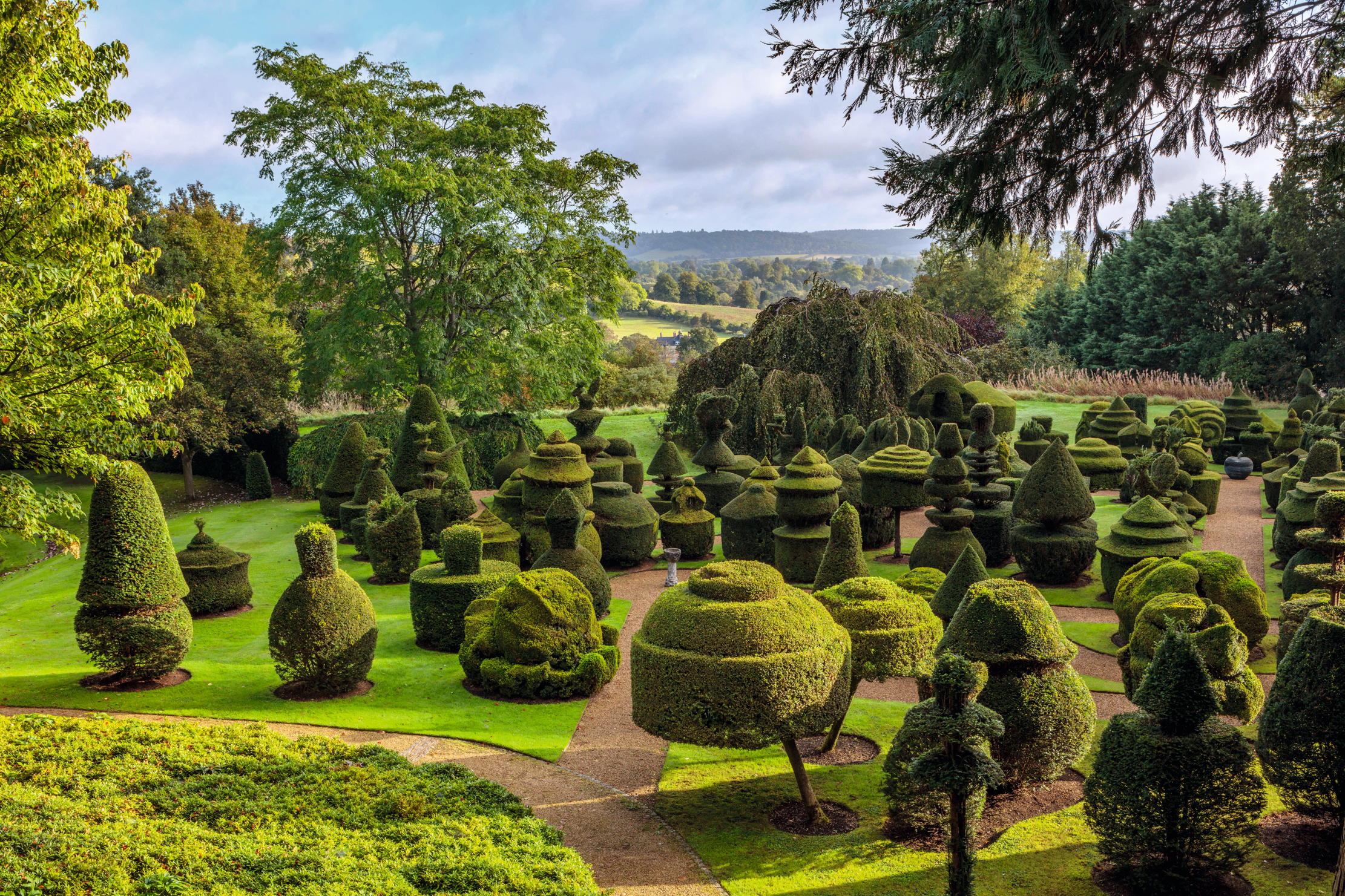
he whimsical topiary gardens at George Harrison’s Friar Park estate, where nature meets artistry. The grounds reflect Harrison’s love of gardening, serenity, and playful spiritual symbolism—each shrub shaped with care and imagination.
- The Unseen Financial Engine: Investments and Other Ventures: Like any individual with a fortune of this scale, George's wealth wasn't just sitting in a vault. It was professionally managed, diversified across a sophisticated array of stocks, bonds, and other financial instruments. While the specifics remain private, these strategic investments would have generated consistent returns, contributing steadily to his growing net worth over the decades.
- His Own Musical Home: Dark Horse Records: Beyond his solo artistry, George also built his own record label, Dark Horse Records, in 1974. While it primarily served as a platform for his own releases and those of artists he personally championed (like the legendary sitarist Ravi Shankar), it added another layer to his diversified financial empire, ensuring another stream of consistent revenue.
This meticulous, multi-pronged approach to building his wealth—marrying his extraordinary musical gifts with astute business decisions and smart property investments—is the real story behind George Harrison's enduring financial success and the thriving legacy his estate continues to manage today.
From Liverpool's Streets to Global Stardom: Harrison's Early Career & Ascent
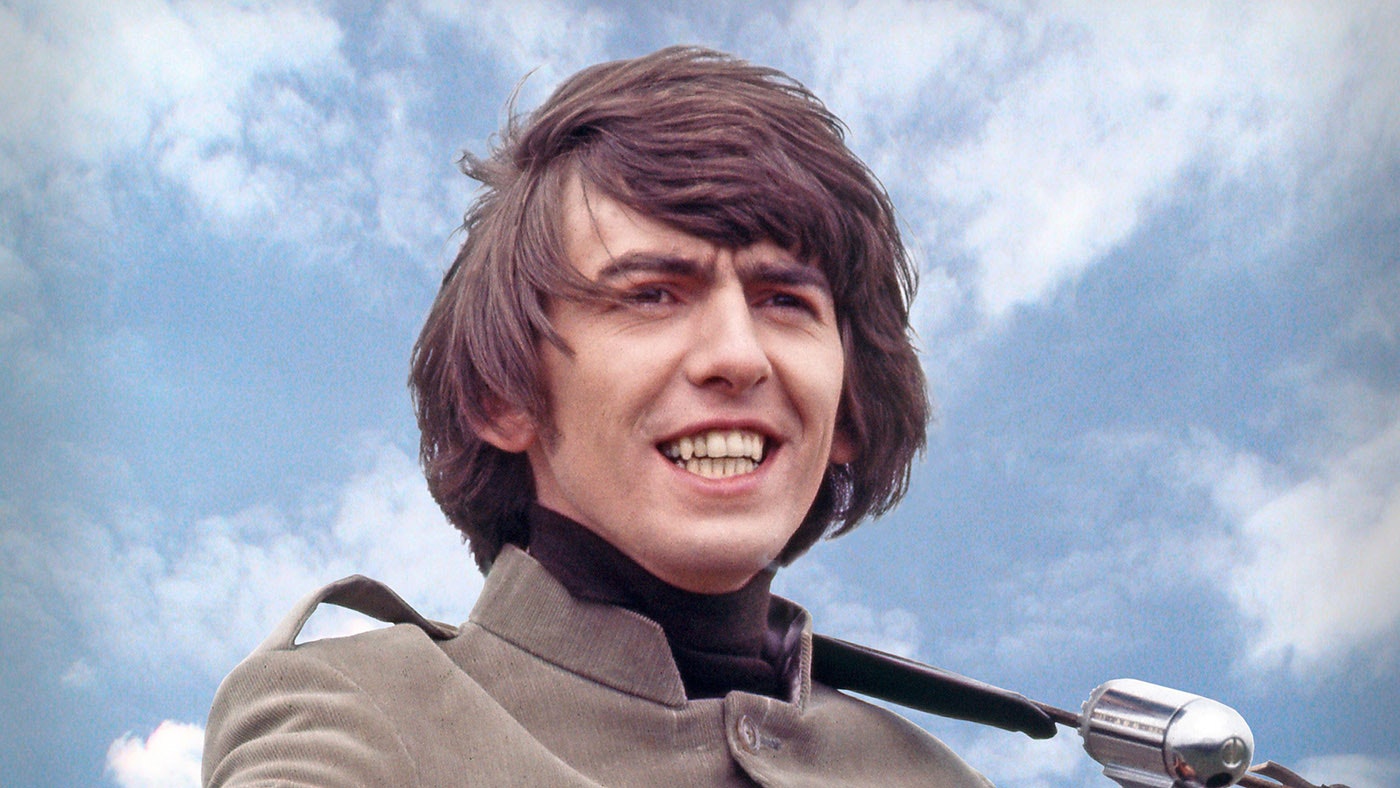
A young George Harrison beams with his trademark charm during the height of Beatlemania, dressed in the iconic mod-style jacket of the mid-1960s, with a microphone just in frame.
Born in Liverpool on February 25, 1943, George Harrison's roots were firmly working-class. His father, Harold, drove a bus, and his mother, Louise, worked in a shop, but her love for music was infectious. As the youngest of four, George picked up the guitar early, practically living and breathing its chords.
By 1958, he found his destiny, linking up with John Lennon and Paul McCartney, forming the core of what would become The Beatles. Initially, he was the quiet, masterful lead guitarist, but soon his own songwriting voice emerged, giving us timeless pieces like "Something" and "Here Comes the Sun" – songs that still flood the airwaves and streaming platforms today.
It was also George who brought the exotic sounds of India and profound spiritual ideas into their music, weaving sitar melodies into tracks like "Norwegian Wood" and "Within You Without You."
The Beatles' journey from humble beginnings to immense wealth was a whirlwind. In those early Hamburg days, back in 1960, they were barely making ends meet, playing endless sets in gritty clubs. But it was there, amidst the chaos, that they truly honed their craft.
:max_bytes(150000):strip_icc():focal(999x0:1001x2)/the-beetles-1-1a971bd703a849268568fcf20bee9fe1.jpg)
The Beatles in their early prime: Ringo Starr, Paul McCartney, John Lennon, and George Harrison captured in a candid moment that defined the look, style, and spirit of the 1960s British Invasion.
By late 1962, with EMI's signing and the release of "Love Me Do," things shifted dramatically. By 1963, The Beatles were not just successful; they were genuinely wealthy, raking in serious money from record sales and non-stop touring. Then came 1964 and "Beatlemania" exploding across America.
The sheer scale of their record sales and sold-out concerts turned them into multi-millionaires almost overnight. Even with some less-than-ideal early merchandising deals and the crushing UK taxes of the era (which famously inspired George's "Taxman"), each Beatle was pulling in millions annually from their global domination.
When the Fab Four parted ways in 1970, George didn't just fade away. He launched a solo career that was nothing short of triumphant. His first album, All Things Must Pass (1970), was a monumental success, featuring the chart-topping single “My Sweet Lord.” This achievement made him the first Beatle to score a No. 1 solo hit, proving his unique artistry could stand firmly on its own.
The Traveling Wilburys & Harrison's Entrepreneurial Ventures

Supergroup royalty: Bob Dylan, Jeff Lynne, Tom Petty, George Harrison, and Roy Orbison pose with their guitars as the Traveling Wilburys, the legendary late-80s collaboration that brought together five of music’s greatest icons.
George's musical journey was far from over when The Beatles ended. He kept evolving, and in the late 1980s, he surprised everyone by co-founding the supergroup The Traveling Wilburys. Imagine the talent: George alongside legends like Bob Dylan, Tom Petty, Jeff Lynne, and Roy Orbison.
Their debut, Traveling Wilburys Vol. 1, released in 1988, wasn't just a hit; it was a phenomenon. This album was a commercial juggernaut, flying off the shelves with over 5 million copies worldwide and earning a 3x Platinum certification in the U.S. (that's over 3 million units!). It wasn't just an American success either, grabbing 6x Platinum in Canada (600,000 units) and Platinum in the UK (300,000 units).
The album even snagged a Grammy for Best Rock Performance by a Duo or Group in 1990. Their second outing, Traveling Wilburys Vol. 3 (yes, they cheekily skipped Vol. 2), also did remarkably well, selling over 3 million copies worldwide. The fantastic thing is, this music continues to pay dividends, evidenced by The Traveling Wilburys Collection box set released in 2007, which shot to number 1 in the UK and number 9 in the US, and has sold over 1.5 million copies globally.
Even if his later solo album releases weren't as frequent as some of his bandmates', George's sheer impact on music and his smart business instincts meant his contributions kept earning him respect and, of course, a healthy income through these collaborative projects and his ongoing astute business ventures.
George Harrison's Estate in 2025: A Thriving Legacy
Here's where it gets truly remarkable: George's estate hasn't just kept pace with inflation; it has actively grown. As we stand in 2025, estimates place George Harrison's estate well above that initial $400 million, potentially even closing in on a staggering $1 billion when you factor in inflation and the sheer resilience of his revenue streams. This impressive growth is a testament to several factors:
- Royalties That Never Quit: His solo songs, and crucially, his beloved Beatles compositions ("Something," "Here Comes the Sun," "While My Guitar Gently Weeps") are still generating immense income. Just think about "Here Comes the Sun" – it's racked up hundreds of millions of streams, a clear indicator of its colossal earning power today.
- Brilliant Estate Management: His wife, Olivia Harrison, and their son, Dhani Harrison, have done an extraordinary job. They've meticulously nurtured George’s artistic and financial legacy, ensuring its preservation and expansion.
- Smart Deals and Fresh Releases: Take the 2022 global publishing agreement with BMG, for instance. This deal now centrally manages George's entire Harrisongs catalog (all 200+ songs!), and even brought his solo recorded works under the Dark Horse Records/BMG umbrella. These kinds of strategic, multi-year deals are designed to maximize and optimize revenue for the long haul.
- Global Demand for All Things George: His image and music are universally recognized. This translates into lucrative licensing deals for films, TV shows, commercials, and a wide array of merchandise – a constant flow of income.
- Thoughtful Posthumous Projects: Albums like Brainwashed (2002), lovingly completed by Dhani and Jeff Lynne, alongside carefully curated reissues and special releases, continually re-engage fans and draw in new ones, adding fresh layers to the already impressive catalog of earnings.
Who Inherited George Harrison’s Fortune?
When George Harrison passed away in November 2001, his significant fortune primarily transitioned to the two people closest to him: his wife, Olivia Harrison, and their only son, Dhani Harrison. Olivia, his devoted partner since their marriage in 1978, became the main beneficiary, inheriting a substantial portion of his estate. Dhani, born in the same year, also received a considerable share.
Dhani Harrison, a gifted musician and producer in his own right, has taken on a pivotal role in stewarding and expanding his father’s musical legacy.
This includes meticulously overseeing posthumous releases like Brainwashed and actively guiding Dark Horse Records. Olivia Harrison, herself a film producer and philanthropist, has also been absolutely instrumental in safeguarding the estate's integrity and continuing George's commitment to various charitable endeavors.
Together, this mother-son duo forms the heart of the Harrison estate management, ensuring that the substantial royalties from George’s incredible contributions to both The Beatles and his solo work continue to flourish.
The Wealthiest Beatles: Who Ranks Where?
While all four Beatles achieved staggering wealth, it's pretty clear who wears the crown: Paul McCartney remains the richest Beatle. As of 2025, his net worth is estimated to be around $1.2 billion, cementing his status as one of the world's wealthiest musicians. This colossal fortune is fueled by his unparalleled solo career, massive global tours that constantly fill stadiums, his substantial share of The Beatles’ catalog royalties, and ownership of rights to various other valuable music catalogs.
Ringo Starr, the ever-charming drummer, also holds a very impressive fortune, with an estimated net worth of approximately $350 million. And John Lennon's estate? It's still incredibly valuable, easily worth well over $200 million, with some estimates placing its inflation-adjusted value and ongoing earnings closer to the $800 million to $1 billion mark.
George Harrison's Royalties: How His Music Continues to Earn
George Harrison's royalties are far from a static sum; they're a vibrant, ongoing stream of income meticulously managed and distributed by his estate. The primary recipients of these ever-flowing royalties, stemming from both his groundbreaking solo work and his absolutely indispensable contributions to The Beatles, are his beloved wife, Olivia Harrison, and his son, Dhani Harrison.
- The Beatles' Royalties: When it comes to The Beatles' music catalog, the complex world of licensing and management is expertly handled by Apple Corps, the company the band members famously founded back in 1968. George's estate, through Olivia and Dhani, consistently receives his significant share of these lucrative earnings from everything – streaming platforms, film and television placements, merchandise, and new re-releases.
- Solo Work Royalties: Royalties from George's iconic solo hits, like "My Sweet Lord" and "Give Me Love (Give Peace on Earth)," are managed through his own publishing entity, Harrisongs Ltd. In a crucial development in 2022, BMG struck a global publishing agreement with the George Harrison Estate to administer the entire Harrisongs catalog, effectively bringing all of his publishing rights under one highly efficient roof. This move ensures optimized revenue generation and also neatly brought his acclaimed solo recorded works under the Dark Horse Records/BMG banner.
Olivia and Dhani Harrison are clearly deeply committed to protecting these invaluable assets, ensuring that this consistent flow of income continues for generations to come, thereby solidifying George's extraordinary and enduring financial legacy.
George Harrison's Passion for Cars: A Glimpse into His Automotive Collection

George Harrison’s iconic purple McLaren F1—a one-of-a-kind hypercar owned by the former Beatle—on display alongside Beatles tributes, blending rock royalty with automotive legend in stunning style.
While money might not buy love, for George Harrison, it certainly bought a remarkable collection of cars – an investment he seemed to value greatly.
To call him merely a car enthusiast would be a significant understatement; he adored automobiles. This passion, at times, seemed to sit uncomfortably with his spiritual desire to eschew the material world's excesses, yet it was an undeniable part of his life. His fascination extended to the world of motorsports, leading him to follow the Formula One World Championship for nearly a year.
His enthusiasm might have been a little too inspired at times, as he had his driver's license revoked twice for reckless driving, including a serious accident in 1972 with his then-wife, Pattie, which nearly cost her life. While the exact number of cars he owned remains elusive due to his frequent buying and selling, his taste was far from pedestrian. Here’s a fraction of the notable vehicles that graced George Harrison’s garage:
- Ford Anglia 105E: Before the array of luxury vehicles, George’s very first car was a second-hand blue Ford Anglia 105E, acquired in March 1962. It was a modest start for a future legend.
- Jaguar E-Type/XKE (1964): Reportedly a 21st birthday gift from Brian Epstein in February 1964, this custom E-Type Coupe even featured a dash-mounted record player. Harrison’s playful humor about the car was evident in a seven-point plan he wrote for a fan on how to wash it, humorously suggesting the dirty water be dumped on Paul McCartney’s Ford Classic.
- 1965 Aston Martin DB5: In 1965, Harrison acquired his first truly extravagant car, a white DB5. This iconic vehicle was later sold at auction in December 2011 to an anonymous Beatles collector for a significant £350,000.
- Porsche Phase (late 1970s-early 1980s): Harrison entered his Porsche phase in the late 1970s, owning two 911 Turbos, a 924 Carrera GT, and a black 928 S Coupe (bought in 1980). The 928 S was later famously bought for parts by a car enthusiast whose wife discovered its celebrity provenance in the logbook.
- Mercedes 300 SEL (1970): Among two Mercedes purchased in 1970 (a red 250 CE and a white 6.3-liter 300 SEL), the latter was the car involved in the serious 1972 accident with Pattie Boyd, highlighting the sometimes dangerous side of his driving passion.
- Mercedes-Benz 600 Pullman Limousine: Originally owned by John Lennon, this luxurious, six-meter-long beast with a drinks cabinet and privacy screen was sold to Harrison in 1971 when Lennon moved to New York.
- Mercedes 500 SEL AMG (1984): This was arguably the car George drove the most. He bought it in 1984 and spent a hefty £85,000 on custom upgrades, including suspension and body kit modifications. He kept it for 15 years, clocking up 30,000 miles.
- McLaren F1 (1994): The priciest and most exclusive car on his list, only 106 of these custom-made supercars were built. Harrison’s F1 featured a unique dark purple pearl exterior, black satin wheels, and personal touches reflecting his Hindu faith, including the "Om" symbol on the wheel hubs and Ganesha idols embedded within the chassis. It remains owned by his estate, despite attempts by Eric Clapton to acquire it.
- Austin Mini Cooper S (1965): Perhaps the most iconic. Gifted to him by Brian Epstein, Harrison's Mini was extensively customized by Harold Radford and later famously decorated with psychedelic art for the Magical Mystery Tour film. Though he briefly gave it to Eric Clapton, he later regretted it, and Clapton eventually returned it.
These vehicles not only showcase George Harrison's eclectic taste but also underscore his deep, personal connection to the world of motoring, a significant facet of his life alongside his music and spirituality.
The Man Behind the Music: George Harrison's Personal Journey and Deep Spirituality
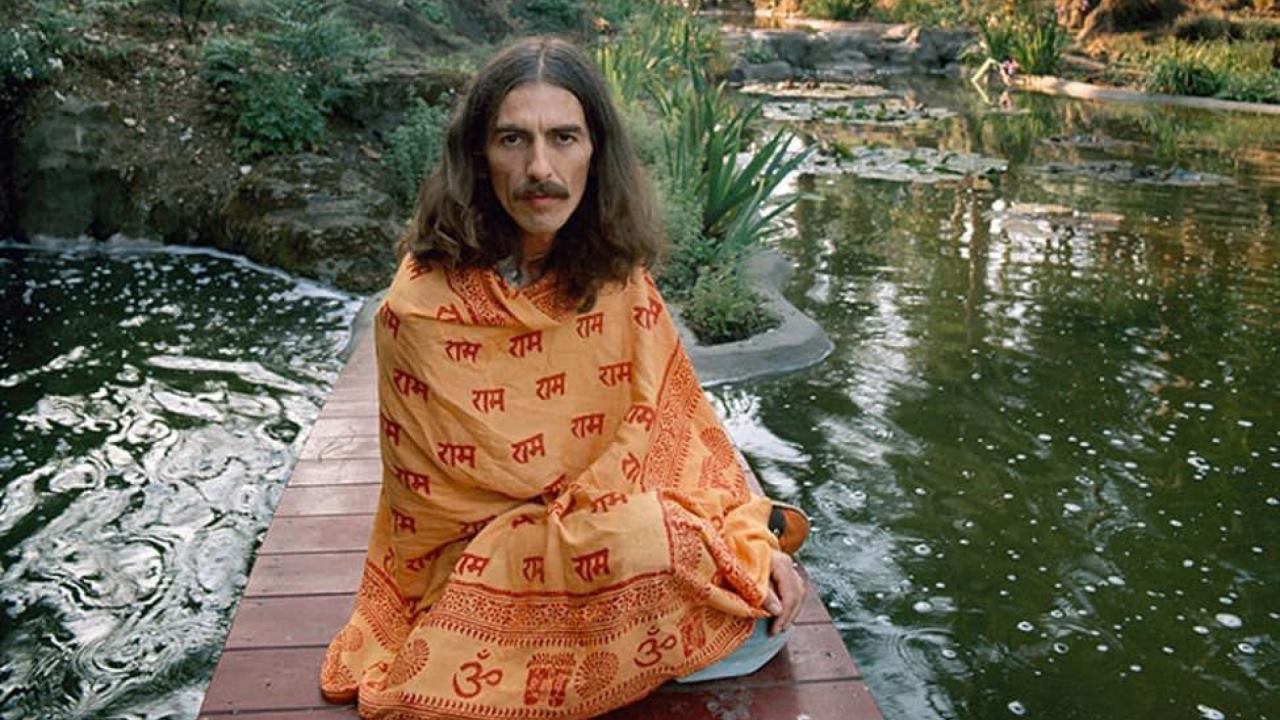
Embracing Eastern spirituality, George Harrison meditates in a peaceful garden setting, draped in a saffron shawl adorned with sacred Hindu text—a reflection of his deep connection to Indian philosophy and the teachings of Lord Rama.
Beyond the dazzling public persona, George Harrison's personal life, though often kept private, was shaped by profound relationships and an unwavering spiritual quest.
His marriage to Olivia Trinidad Arias in 1978, followed by the birth of their son, Dhani, later that year, defined his later life. Their bond was one of deep mutual respect and love, with Olivia providing immense strength and unwavering support through George's courageous battle with cancer in his final years.
Before Olivia, George was married to the striking model and actress Pattie Boyd from 1966 to 1977. Their intricate relationship, filled with both joy and turmoil, famously inspired some of his most tender and iconic songs, including the timeless "Something."
But more than just his relationships, George was immersed, truly immersed, in spirituality and Indian philosophy. This wasn't a fleeting interest; it fundamentally shaped his music and his entire life. He became a devoted follower of the Hare Krishna movement, and his compositions often resonated with powerful themes of peace, universal love, and spiritual enlightenment.
George Harrison's Global Impact: Legacy & Famous Friendships

Legends in harmony—George Harrison and Bob Dylan share the stage during a rare live collaboration, blending their iconic songwriting styles in a moment of musical history that reflects their deep artistic friendship.
George Harrison's legacy isn't just alive; it resonates globally, louder than ever, even decades after his passing. We celebrate him not only for his indispensable contributions to The Beatles' sound and his iconic solo work but also for something deeper. Beyond the music, George's quiet dedication to philanthropy, his passionate advocacy for peace and love, and his tireless spiritual explorations left an indelible mark on global culture.
And then there were his friendships. While he valued many, his bond with Bob Dylan was something special. George once reflected, "Bob Dylan is the most consistent artist there is. Even his stuff, which people loathe, I like. Every single thing he does represents something that’s him.
He may write better songs tomorrow, sing high on this album and low on another, go electric or acoustic, go weird or whatever, but the basic thing that causes all this change is an incredible character named Bob Dylan." With a knowing twinkle in his eye, George would often add, "He’s the looniest person I know!" This candid mix of deep admiration and affectionate teasing perfectly captures Harrison's respect for Dylan's raw authenticity and endless reinvention—qualities he truly cherished.
Today, the Harrison estate, carefully and lovingly managed by his family, remains one of the music industry's wealthiest. The steady flow of royalties ensures that his extraordinary legacy stays vibrant, alive, and accessible to new generations of artists and fans worldwide. George Harrison's life and music stand as a powerful testament to artistic integrity, profound spiritual depth, and a relentless exploration of what it means to be truly human—a legacy that, without a doubt, will continue to inspire for countless generations to come.
People Also Ask:
What caused the death of George Harrison? George Harrison's life ended on November 29, 2001, at the age of 58. His primary cause of death was lung cancer, which tragically spread to his brain. This came after he had successfully been treated for throat cancer a few years prior, in 1997.
Did George Harrison see Pattie Boyd before he died? Yes, in a poignant moment, George Harrison did see his first wife, Pattie Boyd, not long before he passed away. According to Boyd herself, he visited her just a few months before his death, and she felt, despite his brave demeanor, that he was subtly saying his goodbyes.
How many cancers did George Harrison have? George Harrison bravely fought at least two distinct forms of cancer. He received treatment for throat cancer in 1997, a condition he sadly attributed to his smoking. Then, in 2001, he was diagnosed with lung cancer, which subsequently metastasized to his brain, ultimately leading to his passing.
What was George Harrison's net worth when he died? When George Harrison died in 2001, his net worth was estimated to be a substantial $400 million. If we adjust that for inflation to today's values, that figure would be closer to an impressive $700 to $800 million in 2025 dollars. And thanks to ongoing royalties and shrewd management by his estate, that value has continued to grow significantly since.
For more rock legends’ and celeb fortunes, explore our full list of musician net worth articles
-
Robert Plant Net Worth 2025: Led Zeppelin's Voice Commands $200 Million
-
Bob Geldof Net Worth 2025: $150M Fortune & How He Earned It
-
Joe Pesci Net Worth: Hollywood Icon’s $50 Million Fortune
-
Paris Jackson Net Worth 2025: Inside Her $150M Inheritance
-
The Billionaire Riffs: The World's 14 Richest Guitarists in 2025
-
Beyond the Shades: What Was Roy Orbison's True Net Worth?
Disclaimer: How We Estimate Net Worth
Our net worth figures are estimates based on publicly available information, including real estate records, reported earnings, public filings, industry data, and expert analysis. Because private financial details are rarely disclosed, these numbers reflect approximations rather than precise amounts. We regularly update our estimates to incorporate new information and ensure ongoing accuracy.



